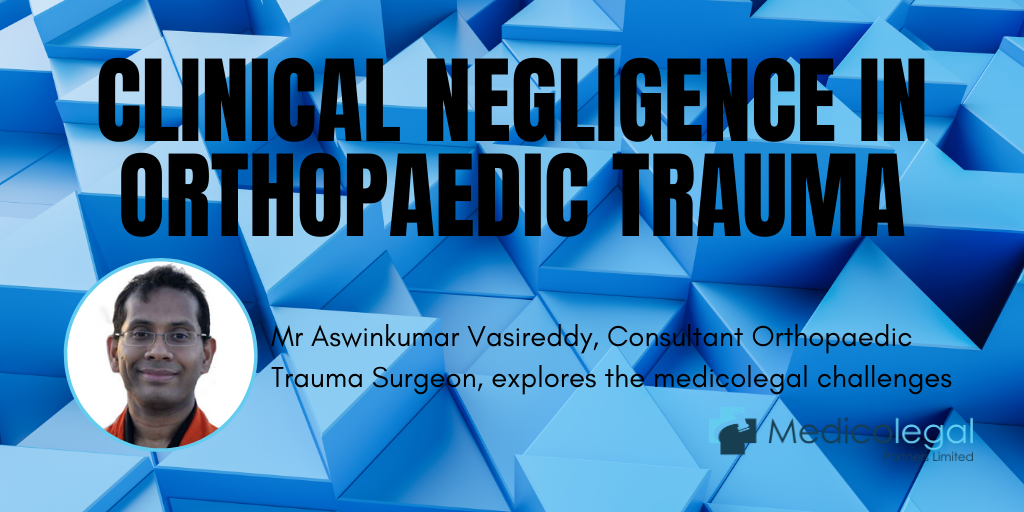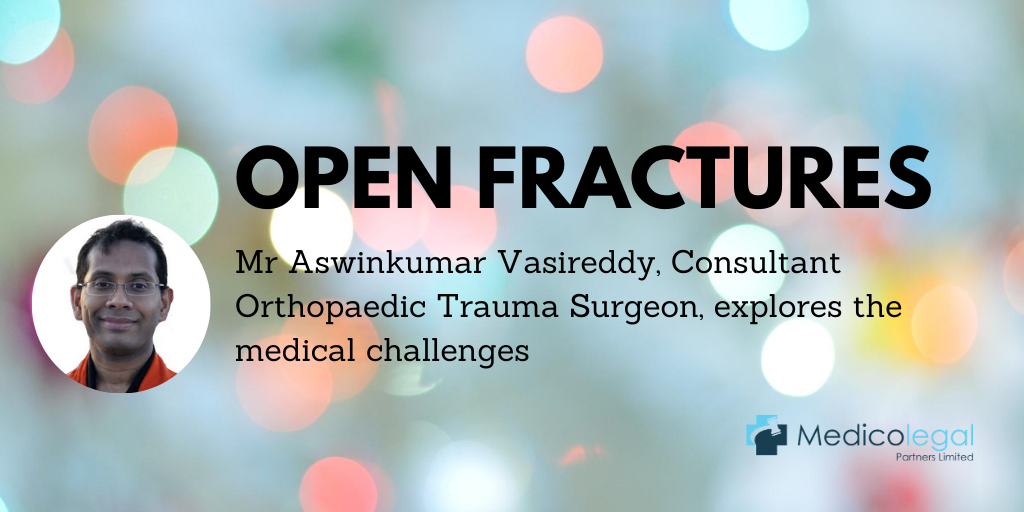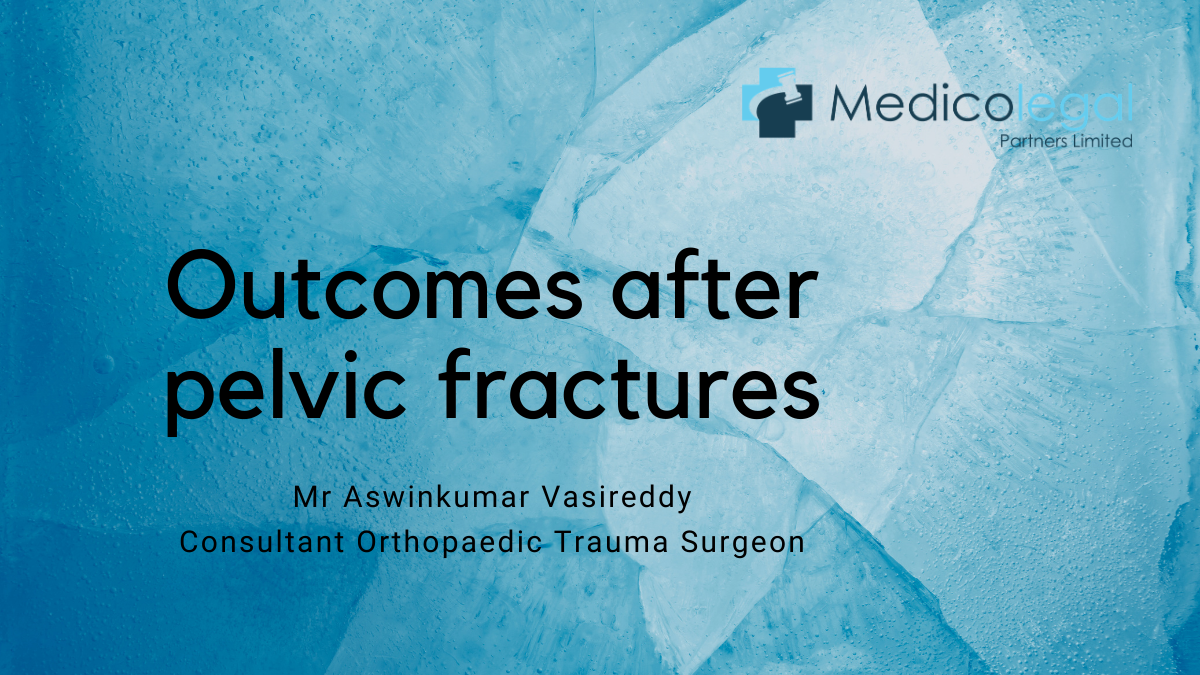A Medicolegal Perspective on Outcomes After Knee and Hip Injuries

Due to their weight-bearing function, injuries to the hip and knee joints have profoundly significant consequences. Each year in the UK, there are over 75,000 hip fractures and around 20% of all adults report knee pain lasting at least one week. Mr Aswinkumar Vasireddy, Consultant Orthopaedic Trauma Surgeon, provides a medicolegal perspective on outcomes after knee and hip injuries.
The knee joint is a highly complex joint that is stabilised by numerous ligamentous structures. The anterior cruciate ligament (ACL) is particularly prone to damage, usually from shearing forces across the knee caused by twisting mechanisms of injury. Most tears are the result of noncontact injuries, such as slipping, falling or during sporting activities. Ideally, evaluation of the knee should take place as soon as possible after the injury has occurred. It is important that concomitant injury to the meniscus, collateral ligaments and bone contusions are identified. However, due to the presence of pain and swelling, a full examination is often not feasible. ACL injuries can be treated conservatively or surgically. While surgery is the preferred option for patients wishing to return to a high level of activity, they must be prepared to commit to a rehabilitation programme lasting at least several months to achieve the best outcome. This must be clearly addressed during the informed consent process. ACL injuries carry a high risk of long-term consequences, with around 90% of patients going on to develop osteoarthritis in the knee 10–20 years after the initial injury.
Knee dislocation is rare but can have serious consequences if not diagnosed properly. The condition can be challenging to manage, as the pattern of injury varies greatly between individual cases. Often multiple ligaments are ruptured and major damage can also be inflicted on surrounding blood vessels and nerves. The popliteal artery is at particular risk because of its location. If the arterial flow is disrupted and not restored quickly, there is a high risk that amputation of the limb below the knee will be necessary. The extent of nerve injury associated with knee dislocation varies but occurs in around a quarter of all cases. Unfortunately, the prognosis following nerve damage is not good, with only around 50% of cases recovering good function. Given the potentially serious consequences of a knee dislocation, doctors should maintain a high index of suspicion when examining an acutely injured knee. Missed vascular injuries can be particularly devastating for the patient.
Sometimes, an injury to the hip or knee is so severe that replacement surgery of the joint is required. Usually, such procedures are extremely beneficial, both in terms of improvements in the recipient’s quality of life and cost-effectiveness. However, as with all treatments, in a minority of cases, complications can arise. This is not that surprising, given that both hip and knee replacements are major procedures. The most common complaint following hip replacement is nerve injury, often manifesting as ‘foot drop’. Another complication is leg length discrepancy. Dislocation is also relatively common, both in first-time surgeries and revision cases, where infection may also be a problem.
Infection-related issues and chronic pain can also occur after knee replacement. There has also been a recent rise in claims relating to technical errors, such as malalignment and incorrect prosthesis or prothesis size, and for non-specified dissatisfaction with the outcome. These rises are all the more noticeable as the overall level of litigation for this type of surgery has actually fallen over the last decade. A number of missed diagnoses have also been reported, which is perhaps surprising, given the increased availability of imaging techniques. The number of cases citing alleged negligence highlights the need for a clear explanation of the procedure, including possible risks, before surgery so that the patient’s expectations are realistic.
As with ACL surgery, rehabilitation plays an important role in the outcome of knee and hip replacement procedures. Early mobilisation is desirable because it decreases the length of hospital. It is also highly dependent on the patient’s pain tolerance. Furthermore, the success of any rehabilitation programme is strongly influenced by the patient’s commitment and it is important that the patient understands this before surgery takes place.
Careful patient selection may reduce the risk of adverse events. The usual indications for carrying out a joint replacement are pain, loss of function, radiological changes and the failure of conservative therapy. It is vital that the reason for surgery is clearly recorded, to avoid a future claim that the procedure was not indicated for that particular patient. Ensuring the patient’s fitness for surgery may also improve the outcome. Known risk factors for infection include previous open surgical procedures, immunosuppressive therapy, poor nutrition, diabetes mellitus, obesity and smoking. Efforts should be made to improve these aspects of the patient’s condition where possible. These measures should help to reduce the possibility of a future claim being made.
About Mr Aswinkumar Vasireddy
Mr Vasireddy is a full-time fellowship-trained Orthopaedic Trauma Surgeon at King’s College Hospital. He specialises in the management of complex open/closed pelvic, acetabular, upper limb and lower limb fractures and amputations in his clinical and expert witness work. He is also one of a small group of surgeons, and the only contemporary Orthopaedic Surgeon, in the UK who works as a HEMS (Air Ambulance) Pre-hospital Care Doctor.
He qualified at Guy’s, King’s & St. Thomas’ Medical School and completed his orthopaedic training on the prestigious South East Thames Rotation. He completed specialist Orthopaedic Trauma Fellowship training both in the UK and USA.
His medico legal practice includes those who have sustained high-energy injuries. With his training, he’s able to provide comprehensive reports and review all aspects of a patient’s treatment. His consultation rooms are in London and Essex, he may be available for domiciliary visits in London and the South East.
Find out more about his particular areas of specialism and download his CV here.
Further reading:
Sanders AK, Boggess BR, Koenig SJ, Toth AP. Medicolegal issues in sports medicine. Clin Orthop Relat Res. 2005 Apr;(433):38-49. doi: 10.1097/01.blo.0000159764.03919.33. PMID: 15805935.
McWilliams AB, Douglas SL, Redmond AC, Grainger AJ, O’Connor PJ, Stewart TD, Stone MH. Litigation after hip and knee replacement in the National Health Service. Bone Joint J. 2013 Jan;95-B(1):122-6. doi: 10.1302/0301-620X.95B1.30908. PMID: 23307685.




